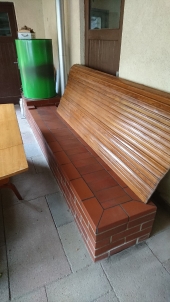
 2
2








 3
3




Oystein Tandberg wrote:Greetings RMH community!
After more than 12 years of reading, planning and preparing the groundwork, I am getting ready to move into the construction of what I think of as the heart of the house.
There are some final considerations I need to make.
First, I needed to dig out the space for the construction. I made the bench in natural stones. And, I made a stone wall where the core will be built. So it will be partly built into a structure of stones. Within that space, I can fit a burn tunnel of one meter. That will leave enough space to insulate the walls, so that the heat will not damage the cement, and tumble the walls.
I will cast the core. I will make a mix of puffed silica (bought in bags, used here on the sidewalks in winter, to prevent people from falling on the ice). I will use water glass as the binder, and I will mix a small amount of refractory cement (resisting 1000 Celsius) into the mix. And some sand.
The considerations I need to make now is what dimensions to choose. I find it easier to navigate when I understand the principals - for example, the distance between the top of the heat riser and the barrel, how would that be affected by the two different dimensions - or rather, how can I calculate the length based on how I expect the build to function? Should I for example make a shorter and smaller core, to leave even more space to separate it from the stone walls? I will also use leca (puffed clay) to protect the stone walls, and glass.
I will make a chimney on the outside to ensure a good draft. And I will include in this chimney a place to make a small fire, to be able to heat it before I start a fire on the inside.
Best regards
 3
3





 5
5




For all your Montana Masonry Heater parts (also known as) Rocket Mass heater parts.
Visit me at
dragontechrmh.com Once you go brick you will never go back!
 4
4




thomas rubino wrote:Hi Oystein;
5 cm (1.9") is much too small
10cm (3.9") will work well.
20 cm (7.8") will also work.




 5
5




For all your Montana Masonry Heater parts (also known as) Rocket Mass heater parts.
Visit me at
dragontechrmh.com Once you go brick you will never go back!
 2
2




thomas rubino wrote:The effect of a larger distance from the riser to the barrel top will be, lower radiant heat released from the barrel and more heat passed into the mass.
Riser height should not be more than 48"(122cm) but not less than 36" ( 91.4cm) measured from the floor of the core.
 3
3




thomas rubino wrote:
Riser height should not be more than 48"(122cm)...
 2
2




here is an updateOystein Tandberg wrote:
thomas rubino wrote:
Riser height should not be more than 48"(122cm)...
I took some pictures for illustration
![Filename: 74A4ED86-0452-4F9F-8142-58443D4D029C.jpeg
Description: [Thumbnail for 74A4ED86-0452-4F9F-8142-58443D4D029C.jpeg]](/t/256987/a/243061/74A4ED86-0452-4F9F-8142-58443D4D029C.jpeg)
 1
1




 3
3




Scott Weinberg wrote:
Oystein Tandberg wrote:
I will cast the core. I will make a mix of puffed silica (bought in bags, used here on the sidewalks in winter, to prevent people from falling on the ice). I will use water glass as the binder, and I will mix a small amount of refractory cement (resisting 1000 Celsius) into the mix. And some sand.
After 12 years of reading-planning, this mixture you talked about? Someone has proven it already for casting?
How permies.com works
What is a Mother Tree ?




Burra Maluca wrote:
Scott Weinberg wrote:
Oystein Tandberg wrote:
I will cast the core. I will make a mix of puffed silica (bought in bags, used here on the sidewalks in winter, to prevent people from falling on the ice). I will use water glass as the binder, and I will mix a small amount of refractory cement (resisting 1000 Celsius) into the mix. And some sand.
After 12 years of reading-planning, this mixture you talked about? Someone has proven it already for casting?
Waterglass is sodium silicate which is used in CO2 sand casting.
I tried to raise the subject here years ago as a friend of mine used to use it for casting experimental parts for jet engines, but no-one ever really showed any interest.
I'll be fascinated to see someone actually trying it for casting rocket cores.
Here's the thread, from seven years ago - shippable cores - could CO2 sand be the answer?
Ok, I will ask this differently. in one place it quickly told the ratio was 500 grams of sand to 30 grams of Sodium Silicate. And then CO-2 method of quickly curing.
I did not find any reference of adding other items for insulating purpose, or ratio's of such.??
Nor did I find how durable any of this would be Day after day of fire, with the included wood loading. and for years.??
Maybe I have missed this somewhere?
The guy is now my neighbour and I'd be happy to pick his brains about it if anyone want me to.
 4
4




 2
2





 4
4




 2
2




Øystein Tandberg wrote:Thank you guys - great video! I will watch it again a few times before I comment.
.




Glenn Herbert wrote:... I think the air would be moving so fast that you would have a ton of excess air which will only cool the system. .

| I agree. Here's the link: http://stoves2.com |




